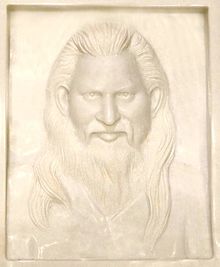Acharya Sushil Kumar
| Sushil Kumar | |
|---|---|

Picture of a marble plaque showing Acharya Sushil Kumar (from a private collection)
|
|
| Religion | Jainism |
| Sect |
Śvētāmbara; non-sectarian Sthānakavāsī; Arhat Sangh |
| Personal | |
| Born | 15 June 1926 |
| Died | 22 April 1994 (aged 67) |
Sushil Kumar (15 June 1926 – 22 April 1994) was a Jain teacher and monk (later Acharya). His primary ashram in North America, Siddhachalam, located in Blairstown, New Jersey was established in 1983. He was among the founding fathers of American Jainism.
He was born in Shikhopur, in modern day Haryana in India on June 15, 1926. At the age of eight, he started living with Shri Chotelalji Maharaj, a Jain monk. When he was fifteen years' old, he formally renounced the life of a householder and became a Jain monk. He began to gain renown as a yogi and a repository of wisdom at an early age and came to be addressed as Guruji.
Although he was ordained as a monk in the Sthānakavāsī Jain tradition, he regarded himself to be non-sectarian. In 1979, he formed Arhat Sangh, a syncretic, non-sectarian group within Jainism.
Sushil Kumar was born into a Brahmin household. As a Jain monk, he traveled on foot thousands of miles across the length and breath of India. He represented the Sthānakavāsī Jain tradition in the making of Saman Suttam, a compilation of Jain principles that was acceptable to all sects of Jainism. He discovered and mastered the secrets of sounds behind the Namokar Mantra, an auspicious rendering that is central to Jains and wrote a book on the subject, Song of the Soul.
For hundreds of years and as long as historical records are available, Jains monks did not use any mechanical means for travel. This was notwithstanding evidence that Lord Mahavira used boat to cross river Ganga when he was a monk. Yet, on June 17, 1975, at the height of his popularity as a monk, Muni Sushil Kumar made the fateful decision to travel outside India by use of an aircraft. That solitary act could be one of the most significant events in the history of Jainism in modern times. It opened doors to many Jain monks and nuns using mechanical means of travel, including outside India. As expected, the decisions caused some controversy in the Jain community.
...
Wikipedia
